 Our World
Our World  Our World
Our World  Miscellaneous
Miscellaneous 10 Intriguing Origins of Popular Carnival Rides
 Weird Stuff
Weird Stuff Ten Unexpected Discoveries Involving Vomit
 Movies and TV
Movies and TV 10 Actors Who Almost Didn’t Take Career-Defining Roles
 Technology
Technology 10 Little-Known Shifts in Computer Science
 Religion
Religion 10 Catholic Histories That Reveal Acceptance of Abortion and Contraception
 Politics
Politics 10 Lesser-Known “First and Only” Facts about U.S. Presidents
 Miscellaneous
Miscellaneous 10 Things You May Not Know about the Fourth of July
 History
History 10 Shocking and Gruesome Founding Father Facts They Don’t Teach in School
 Crime
Crime The Ten Most Vicious Los Angeles Killers
 Our World
Our World 10 Surprising Secrets of Notre Dame Cathedral
 Miscellaneous
Miscellaneous 10 Intriguing Origins of Popular Carnival Rides
 Weird Stuff
Weird Stuff Ten Unexpected Discoveries Involving Vomit
Who's Behind Listverse?

Jamie Frater
Head Editor
Jamie founded Listverse due to an insatiable desire to share fascinating, obscure, and bizarre facts. He has been a guest speaker on numerous national radio and television stations and is a five time published author.
More About Us Movies and TV
Movies and TV 10 Actors Who Almost Didn’t Take Career-Defining Roles
 Technology
Technology 10 Little-Known Shifts in Computer Science
 Religion
Religion 10 Catholic Histories That Reveal Acceptance of Abortion and Contraception
 Politics
Politics 10 Lesser-Known “First and Only” Facts about U.S. Presidents
 Miscellaneous
Miscellaneous 10 Things You May Not Know about the Fourth of July
 History
History 10 Shocking and Gruesome Founding Father Facts They Don’t Teach in School
 Crime
Crime The Ten Most Vicious Los Angeles Killers
Top 10 Fascinating Facts About The Mind Of A Dog
Dogs aren’t just walking husks of drool and poop. Their brains aren’t just limited to the three commands of “sit,” “fetch,” and “stay.” Even if you haven’t owned a dog yourself, you should know that they are one of the most intelligent creatures on the planet that we can proudly have by our sides as humans. Dogs can even suffer the same afflictions that affect human’s brains as well. They might not be able to solve linear equations (neither can some humans who slept through algebra), but they can understand more than you think they can.
More and more scientific research is coming out about the mind of dogs, what they’re thinking inside, and how they interpret their surroundings. Although we may never know every single detail about the mind and body of dogs, the significant amount of progress we have made so far has given us more of an insight and a better understanding of canine cognition. Let’s take a look at ten interesting facts about the mind of a dog.
10 Dogs Can Suffer Depression And Anxiety Too

Every time you see a dog on a Facebook video (or even own your own ball of energy), you assume they’re just ready to party at any given moment. However, dogs can suffer depression and anxiety just like humans. Although dogs can be useful to humans in many ways regarding mental health, these furry companions can have struggles as well. Their depression can have triggers that would bring down any human as well such as adding someone new to the family or someone leaving the household. The symptoms of depression in a dog are just about as similar compared to the symptoms of depression in humans. They can lose their appetite, become inactive, lose interest in their favorite activities, and withdraw from the world.[1]
9 Dogs Process Scent Better Than You Think
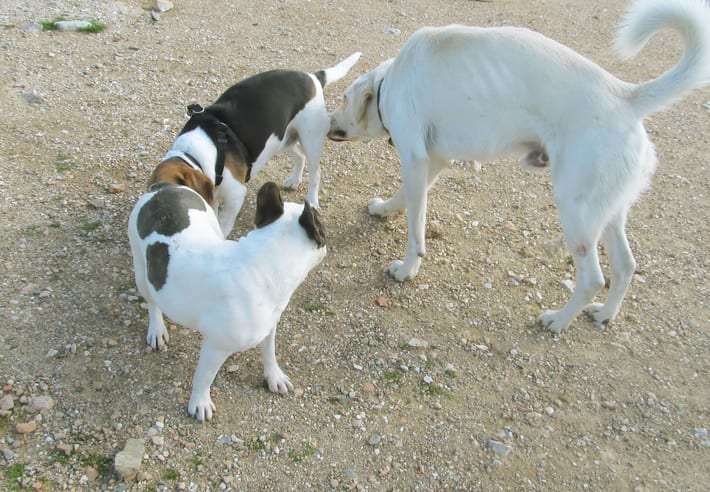
If you ever wondered why dogs sniff at almost everything (including the rear-end of other dogs), then be prepared for a shocker: a dog’s primary sense is smell. They can pick stuff up through their noses that humans can’t. If they couldn’t, then we wouldn’t have bomb or drug-sniffing dogs, we’d just have a bunch of creepy humans on all fours sniffing the floor of a crime scene. Dogs possess up to 300 million olfactory receptors, compared to six million humans.To go more into depth, if you look inside the noses of both humans and dogs, there are bony scroll-shaped plates called turbinates. This organ has a thick membrane which holds most of the scent-detecting cells. In humans, this area of the organ only measures up to about one square inch. If you were able to unfold this same area of the organ in a dog, it could be about as large as about sixty square inches (depending on the size and length of the nose).
A dog’s brain is specialized in identifying scents, which is why dogs rely heavily on their noses to help interpret the world around them. The percentage of the dog’s brain used for analyzing smells is forty times larger than a human brain. Since a dog’s nose is specifically adapted to function better than that of a human’s, they have lots of advantages that we do not. They have the ability to take in air and breathe it out at the same time. The purpose of this is to create an ongoing circulation of air, while us humans only have the ability to breathe in or out only one at a time.[2]
8 Dogs Can Read Our Facial Expressions Just Like Other Humans
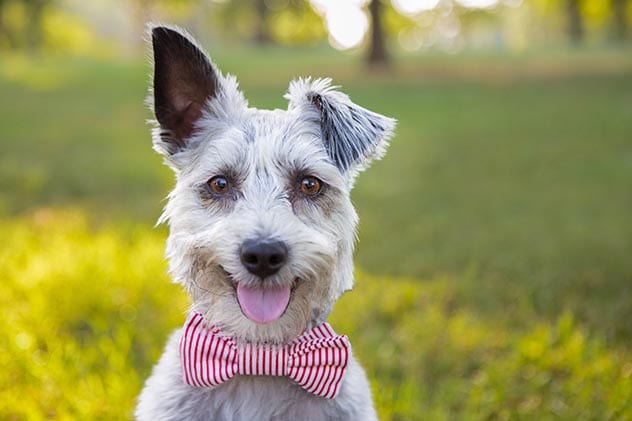
If you look sad, then you may find another human walking up to you and talking in an attempt to cheer you up. Dogs can process a similar reaction to a human’s facial expression. If you smiled at a dog, then a dog will process in its mind that you are happy and will probably smile back at you, in its own way. They may even react more overtly to indicates that they are happy by bouncing around, or wagging their tail, or zooming through your house or yard like a loon.
Evidence suggests that dogs are sensitive to emotional cues conveyed by a human’s face and will even experience an increased heart rate when they perceive that someone is angry, fearful or happy. Research also suggests that dogs have the same social recognition skills that a human infant aged between 6 months to 2 years of age does.[3]
7 Dogs Want To Tell Us What They’re Thinking But They Can’t
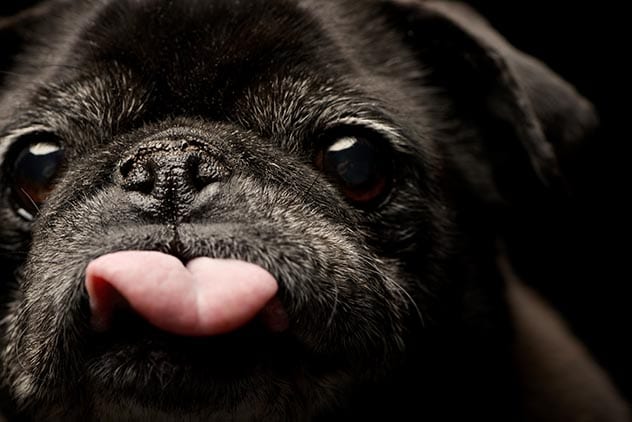
It’s probably very frustrating trying to tell someone something when you just can’t get the words out. It’s like when there’s a language barrier and you’re hoping your weird combination of hand-movements will make someone understand what you’re trying to say. That is the everyday reality of dogs. They want to talk back to us, but can’t.
Dogs don’t have words, but they can communicate with us. They do this through a variety of body language techniques that can give us a wealth of information about what they’re thinking. If we know what to look for. For example, a dog turning their head away and licking their lips tells us they are nervous. If they wag their tail feverishly then we know they are happy.There are five common groups of canine communication signals (Fearful, arousal, anxious, aggressive, and relaxed). The problem we have is sometimes the way they communicate with us is so subtle that we don’t pick up on what they are saying. I guess until a dog can find a way to talk to us, there will always be a lot we don’t know about what they think or feel.[4]
6 Dogs Can Understand What You’re Saying

Dogs might not be able to tell us what they’re thinking, but that doesn’t mean they can’t understand what we’re saying. Dr. Stanley Coren, a canine intelligence expert, says the average dog can understand about 165 words and possibly more with training. Although dogs can learn words as young as humans can, they just can’t reply to anything other than wagging their tails, growling, or tackling us when we ask, “walk?”
Dogs’ brains process language in a similar way to humans, with the right side dealing with emotion and the left processing meaning. They learn, just like a child, that certain sounds mean certain things. For example, the sound of the word “walkies” will quickly be associated with going for a walk, if that is what they do every time you say the word to them.[5]
5Dogs Can Pick Up Auditory Mood Changes

Dogs can have a strong sense of smell, can see if we’re happy or sad, but did you know they can also hear mood changes? If a dog hears something negative (like yelling or a vacuum), then they’ll most likely run for cover. If they hear a human having a good time, then they’re probably going to jump in and start doing that weird dog dance where they bounce their entire bodies because dogs can’t really dance, but they’re doing their best.
It has long been known that dog’s pick up the tone of sounds, including our voices, more than actual words themselves.These sounds will then be attributed to a feeling within their brain, such as joy when hearing the clink of their food dish being taken from the cupboard or fear when they hear the bath running and they are being led into the bathroom.
Have you ever scolded your dog but been unable to do it in a stern voice? Saying “you naughty boy” whilst grinning and laughing will no doubt be greeted with a wagging tail and a bouncy dog. That’s because the tone of your voice sounds happy to them.[6]
4 Humans Have Influenced Dog’s Brains Over Time

Border Collies didn’t just wake up one day knowing how to herd sheep. You also wouldn’t plop a chihuahua in the middle of a field and ask it to put all the sheep in the pen (if anything it would just stand there doing that weird shaking thing chihuahuas do). A dog’s brain varies depending on the breed. Some are wired for hunting while others are wired for sniffing. Most of this behavior was influenced by humans over time by us.
Scientists have proven that the selective breeding we have employed over the years to get the shape, color, or behavior we wanted has also had an impact on the way the dog’s brains work. A dog’s brain has been proven to vary from breed to breed and a lot of this variation is down to our own search for particular behaviors when selective breeding.
What this means is that dogs don’t just vary in size, shape and color but also in the way their brains work.[7]
3 Dogs Can Figure Things Out (Sometimes Better Than Humans)
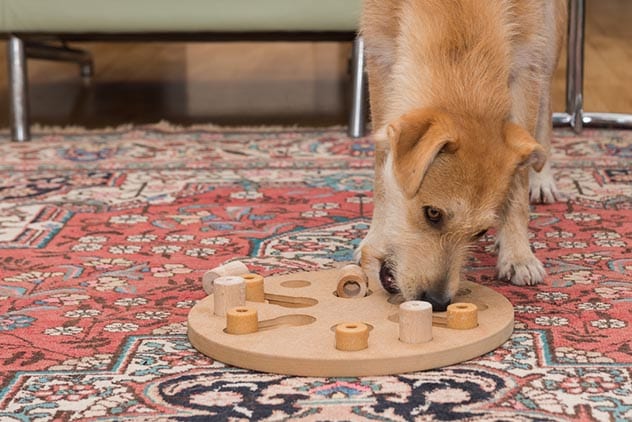
Dogs aren’t just dopey creatures who have a hard time finding the treat when you mix up behind your back and offer both closed hands to see if they can find it. It might be a fun trick to play to try to fool your dog, but they’re actually playing with us as they already know where the treat is (remember, sense of smell). They might also be more rational when it comes to decision-making than humans. Sometimes they won’t take the easy way, they’ll take the smart way, despite what others are doing.
Whereas humans can fall into the trap of what scientists call “over-imitation,” the process of trying to imitate our surroundings and those around us too much, dogs will learn from us but will be more rational in their thought process when deciding whether to follow our behavior. They will watch to see what we do but won’t copy us if the situation doesn’t warrant it. This gives them a more objective brain when it comes to problem solving. When solving a puzzle, for example, we will watch how others tackle the problem and copy them exactly with little variation. A dog will watch what we do but then adapt this to match what they think the problem requires.[8]
2Dogs Are Better At Math Than You Think
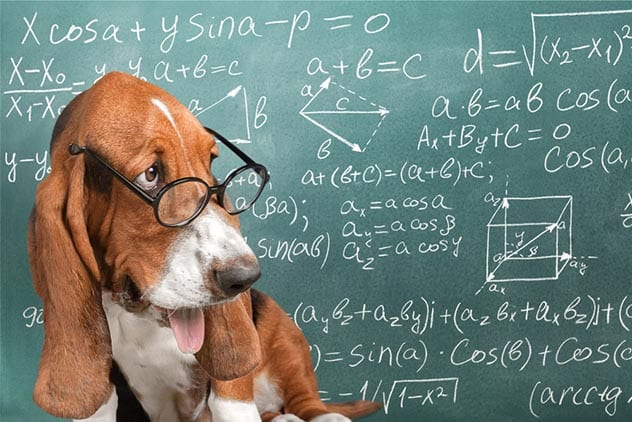
They’re not going to know how to use a calculator or be able to solve y=mx+b, but they know basic arithmetic and can even beat a young child in simple math. Of course, without opposable thumbs, they can’t exactly walk up to a chalkboard and prove they know what 1+1 is, but they can count treats in their heads when you take one away.
Have you ever seen a retriever when out hunting? They will know exactly how many birds they should be fetching without having to be cajoled repeatedly into going out to get another. If three are shot, then three is what they will go and get. After fetching one, they will know there are two more. And after getting the second they will know there is one more. They know this because in a rudimentary way they count.
Another way you will see a dog count is when watching them decide which pile of food they should eat first. If you set out two dishes with differing amounts of dog biscuits on them, they will invariably head for the one with the most on first.[9]
1 Dogs Can Get Jealous Too

No, dogs aren’t scrolling through Instagram obsessively checking who liked your selfie, but they can get jealous of others. You would think dogs just get jealous of other dogs, but they can also be jealous of other humans as well. They might also lash out like the older children in movies or TV shows who hate the fact that a newborn baby is getting all the attention. They aren’t able to take a marker and write all over the walls, but you might see them acting out a little more aggressively or whining when they don’t get their way.
Have you ever neglected your dog so you can speak to a friend? Have they snapped at you or tried to get your attention? That’s because they are feeling jealous. Dogs, like humans, want the attention of their loved ones. They need to feel like you are not neglecting them otherwise strong emotions rise within them.
In conclusion, Doctors and scientists all over the world are still trying to figure out dogs. They may be a very simple animal that can learn a trick or two, but their brains are very complex. There is still a bit of mystery behind why dogs do the things they do, but in the meantime, we have some of the best companions that the human race could ask for. At the very least, we can appreciate that they don’t jump on our keyboards when they want attention like cats.[10]
For more lists like this, check out 10 Horrifying Times Dogs Killed People, and 10 Incredible Rescues By Dogs That Will Warm Your Heart








